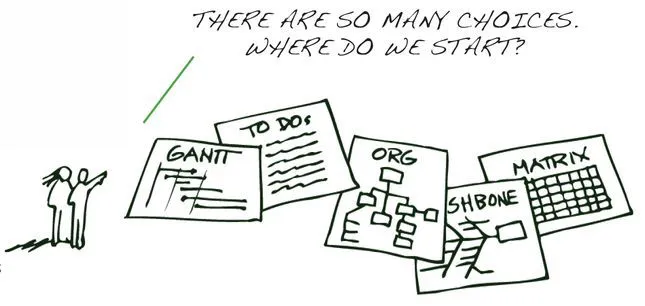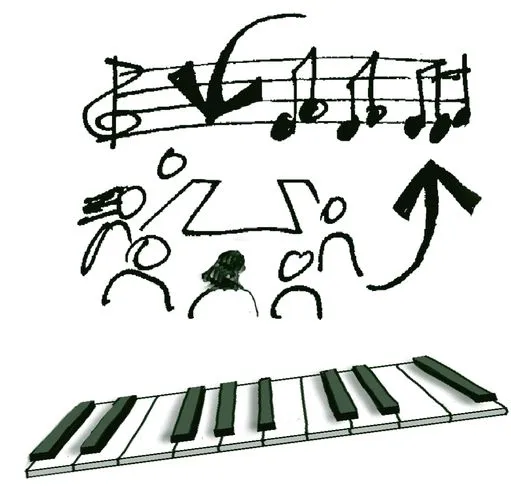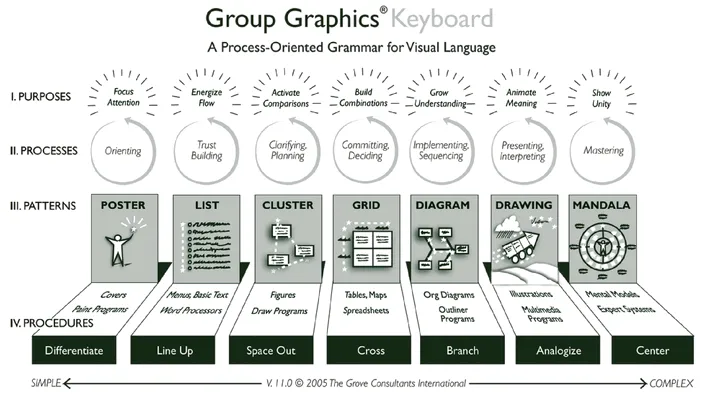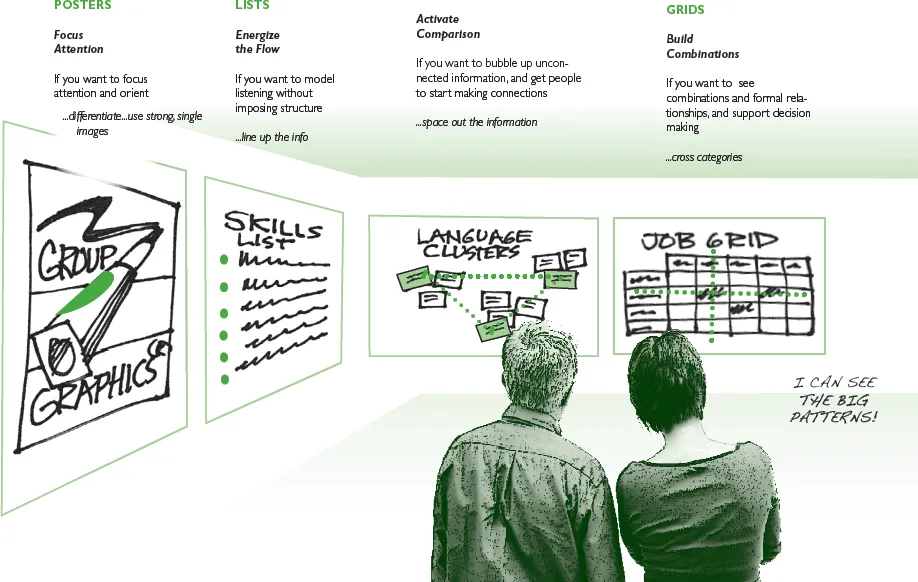![]()
III. Graphics for Visual Thinking
Mapping Ideas & Finding Key Patterns
III: Graphics for Visual Thinking
This section reviews specifics tools for writing on the wall, problem solving, storyboarding, visual planning, and all the ways to get groups to think together and generate breakthrough insights and meaningful plans.
Chapter 9: Group Graphics® How visual meetings are like jazz; the Group Graphics Keyboard; examples, applications and tips; the theory behind the Keyboard.
Chapter 10: Problem Solving How to understand problems and root causes; graphics for simple brainstorming and problem solving; solving wicked problems; understanding systems.
Chapter 11: Storyboarding & Mind Mapping Creating narrative flows with storyboards; thinking in branching patterns.
Chapter 12: Visual Planning Using graphic templates to guide visual planning; The Grove Strategic Visioning Model and Graphic Guides; creating decision support rooms.
Chapter 13: Multiple Groups & Gallery Walks Working with breakout groups; handling report-backs; managing large displays; gallery walks for seeing the big picture.
Chapter 14: Digital Capture Using digital photography for documentation; reporting formats; tips for processing chart photos; using graphics to link data online.
Chapter 15: Visualizing at a Distance How to work visually with web conferencing software; working with tablets; supporting interaction online.
![]()
9. Group Graphics
Seven Ways to Write on the Wall
Any time you face a blank page or chart you will have to choose how to begin. This involves understanding the basic patterns I talked about in Chapter 2 in regard to the Group Graphic® Keyboard, and its seven ways to write on the wall. These are the foundation formats out of which all the other variations emerge and the keys to visual thinking with groups.
How Jazz Works
Let’s begin with a metaphorical side trip that will make all this talk about process more understandable. I personally like to play the piano and have always wanted to play jazz. I grew up being required to have traditional piano lessons with sheet music. I became fairly proficient but eventually rebelled, coming back to playing in college and starting over, making up my own combinations and pieces.
One day I wandered into a small music shop and found myself surrounded by tall piles of sheet music of all kinds stacked on several tables with narrow aisles in between. I came around to the front, overwhelmed. There was an older man who I assumed was the owner. “Can I help you with something,” he asked, peering over his glasses. I was hesitant, but said softly, “I’d like to learn how to play jazz.” The man looked at me up and down and didn’t say anything. Then he reached under the counter and pulled out a book and plopped it on the counter. “Learn your scales,” he said, and went back to his reading.
This was a turning point in my understanding of process. I’d expected to be guided to some pieces of jazz music. What he had given me was a book called Hanon’s Exercises, a book of scales and runs that would exercise my fingers in all the kinds of patterns the hand can make playing a piano. There were no jazz pieces in the book! Why did he give me that one, I wondered? I think I now know. If I simply learned sheet music I would be tied to that one interpretation. By learning the basics I was stepping through the door to true invention and improvisation.
Visual Meetings Improvisation
The examples in this book are like the simple finger exercises that you can combine improvisationally. The formats I describe in this chapter are like the different scales in different keys. The pictographs, ideographs, and words are like notes. Visual meetings aren’t all improvisation. I do like sheet music and you will get great results in visual meetings just applying some of the activities I am recommending in the Steps-at-a-Glance boxes. But if you want to really understand how visuals work most flexibly, learn the keyboard. My hope is that understanding these basic patterns will do for thinking what the piano actually did for music. It allowed musicians to collaborate across boundaries. I imagine the Group Graphics Keyboard can empower conceptual jazz. It certainly has in the network of visual practitioners trained by The Grove over the years.
Thinking about Graphics like Music
So how do you shift to thinking about graphic displays as a process rather than just a pattern? It means starting by understanding that what we are describing is a relationship, not an object. There are two key relationships embedded in any visualization process:
1. Creative Process: The relationship between you and what you are putting on the display as you create it
2. Perceiving Process: The relationship between the display and people who are then using it to make sense of something
It turns out there are only seven basic kinds of relationships! By relationship I mean more than just a static connection. I mean the dynamic interaction between you and the display, and the meeting participants and the display. Visualization is always about both the perceived, and the perceived, and both are ways of thinking.
Here is a chart that shows you the full keyboard of patterns, the purposes they serve, the process they embody, and the procedures involved.
Don’t let this visual overwhelm you. On the next page is a spread that will illustrate this same concept from the point of view of someone walking into a room and seeing a lot of charts on the wall. This spread is then followed by individual spreads on each format, so there is plenty of support for understanding. If you can learn to see the big patterns that underlie all the detail, the design of the big formats gets clearer and the welter of choices simplifies a great deal. Watch a designer sometime. They squint at their work to see the big pattern, purposely knocking out the detail. Then they zoom back into the detail. Macro-micro-squint-focus—this is how our brains make sense of the whole. After you learn the basic seven, the rest is combinations, just like in music. That is what the subsequent chapters are all about. Think conceptual jazz!
GROUP GRAPHICS KEYBOARD
This framework organizes all graphics into seven archetypal processes with the simple ones on the left and the more inclusive, complex ones toward the right.
THE GROUP GRAPHICS® KEYBOARD
SEVEN WAYS TO WRITE ON THE WALL
These seven formats are organized so the simplest is on the left, and the most inclusive and complex on the right. The simpler patterns can nest in the more complex ones, like in nature. The ones you choose to use depend on the intention you have for your meeting or activity within a meeting. Under the names are seven generic properties of each pattern that suggest the purposes of each type of display. The next pages zoom in on each in detail.
POSTER
BEST USE
• Meeting titles
• Themes and logos
• Outcomes, agenda, roles, and rules
• Conceptual models to focus trainings
• Special acknowledgments
LIMITATIONS
• Can only make one point well.
• Too many posters take away the effect.
Posters Focus Attention
The simplest format is a chart that gets attention by being different from other things in the room. Big, single images or titles create a poster effect. Their purpose is to focus attention on a clear, central theme, and generate the potential for something to happen. Although one single image can be considered a constraint, you still have many choices in how you get attention. Color, spacing, exaggeration, and other graphic elements stand out if they are different from their surroundings.
If you study professionally produced posters, like the kind that are on bus stops or on billboards, you might notice that if the overall concept is strong and differentiated enough, then details can be added to provide more information for those who look a second time. On large charts you make, your big titles for different key parts of the meeting should stand out and be readable around the room, clearly different from anything else you record. If you need to include a lot of words, use one illustration to tie them together and create a poster effect, or treat the words themselves in a very graphic way that gets attention.
Imagine participants walking toward your meeting down a hall that is some kind of neutral color, with little bulletin boards, and having them encounter a life-sized cutout like a movie billboard. Most people would look at it. If it is holding a sign with a big title of your meeting that points right at its purpose—then you will have grabbed a participant’s precious attention right at the start. If they walk in the room and a large title or outcome statement is on a blank sheet of paper, they’ll notice that as well and spend a little more time imagining the purpose of the meeting.
This is the “poster effect.” It’s the process of getting people to look where you need them to look. Posters make a point!
THEME AND TITLE POSTERS
As p...








